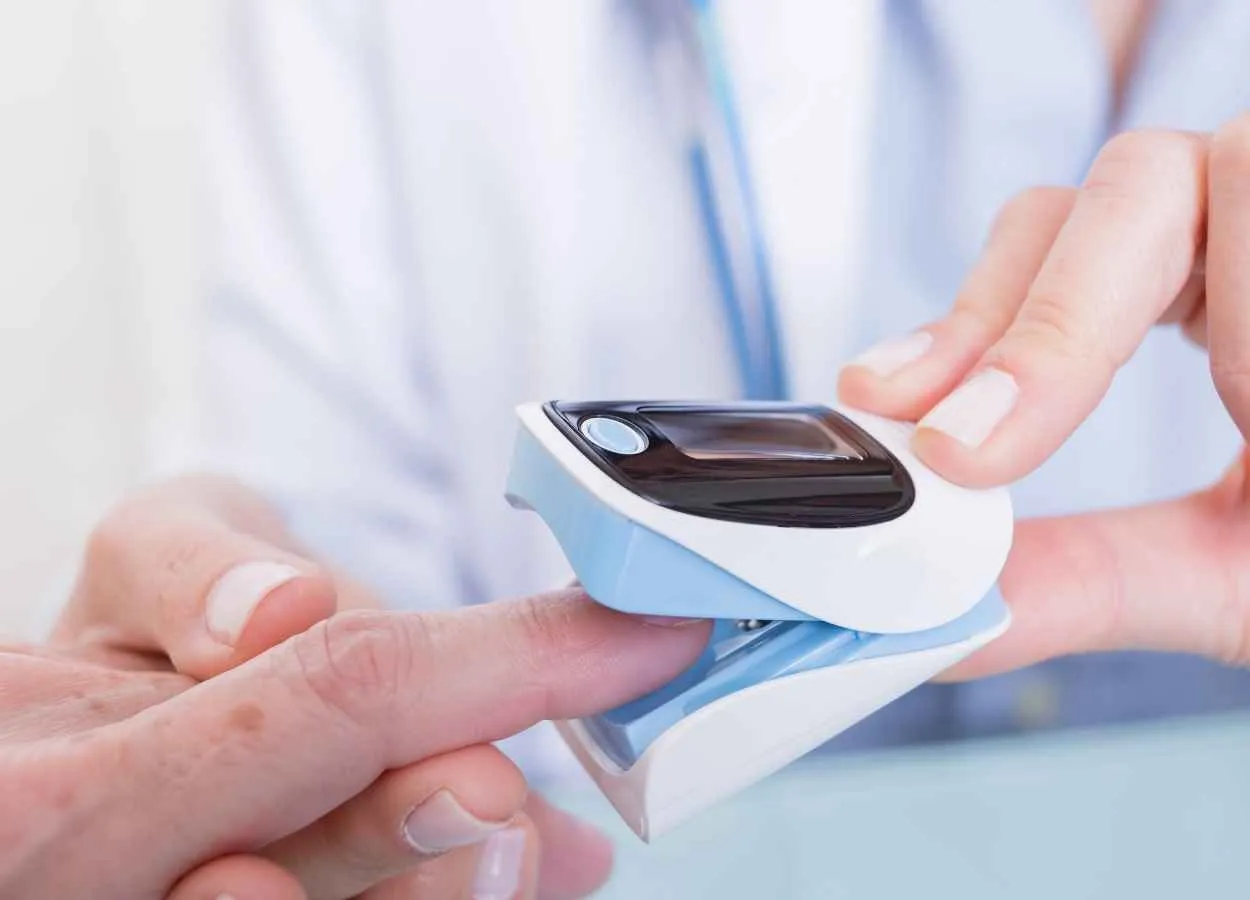The pulse oximeter, which is used for evaluating the oxygen status of patients in a variety of clinical settings, has become an house-hold instrument in this COVID-19 pandemic. It is a way to measure how much oxygen is carrying in blood by using a small device called a pulse oximeter, blood oxygen level can be checked without needing to be stuck with a needle. The blood oxygen level measured with an oximeter is called your oxygen saturation level. This is a percentage of how much oxygen your blood is carrying compared to the maximum it is capable of carrying.
Pulse oximeters do not offer information about hemoglobin concentration, cardiac output, efficiency of oxygen delivery to the tissues, oxygen consumption, sufficiency of oxygenation, or adequacy of ventilation. They do, however, provide an opportunity for deviations from a patient’s oxygen baseline to be noticed immediately, as an early warning signal to clinicians to help prevent the consequences of desaturation and detect hypoxaemia before it produces cyanosis.
How does the pulse oximeter work?
Pulse oximeters measure the absorption of specific wavelengths of light in oxygenated hemoglobin as compared with that of deoxygenated hemoglobin. Arterial oxygenated blood is red due to the quality of oxyhemoglobin causing it to absorb light of certain wavelengths. The oximeter has two light-emitting diodes (LEDs), one red and another infrared which are located on one side of the probe. The probe is placed on a suitable part of the body, usually a fingertip or ear lobe, and the LEDs transmit light wavelengths through pulsating arterial blood to a photodetector on the other side of the probe. Infrared light is absorbed by the oxyhemoglobin; red light by the reduced hemoglobin. Pulsatile arterial blood during systole causes an influx of oxyhemoglobin to the tissue, absorbing more infrared light, and allowing less light to reach the photodetector. The oxygen saturation of the blood determines the degree of light absorption. The result is processed into a digital display of oxygen saturation on the oximeter screen, which is symbolised as SpO2.
There are various makes and models of pulse oximeters available. Most provide a visual digital waveform display, an audible display of arterial pulsations and heart rate, and a variety of sensors to accommodate individuals regardless of age, size or weight. Selection depends on the setting in which it is used.
Arterial blood gas analysis is more accurate; however, pulse oximetry is considered sufficiently accurate for most clinical purposes, having recognised that there are limitations.
Factors which affect accuracy of readings
Patient condition - To calculate the difference between full and empty capillaries, oximetry measures light absorption over a number of pulses, usually five. In order for a pulsatile flow to be detected, there must be sufficient perfusion in the monitored area. If the patient has a weak or absent peripheral pulse, pulse oximeter readings will not be precise. Patients most at risk of low perfusional states are those with hypotension, hypovolaemia and hypothermia and those in cardiac arrest. Patients who are cold but not hypothermic may have vasoconstriction in their fingers and toes that may also compromise arterial flow.

Non-arterial pulses may be detected if the probe is secured too tightly, creating venous pulsations in the finger. Venous pulsations are also caused by right-sided heart failure, tricuspid regurgitation, and the tourniquet effect of a blood pressure cuff above the probe.
Cardiac arrhythmias may cause very inaccurate measurements, especially if there are significant apex/radial deficits.
Intravenous dyes used in diagnostic and hemodynamic testing may cause inaccurate, usually lower, estimates of oxygen saturations. The effects of deeply pigmented skin, jaundice or bilirubin levels should also be considered.
Using pulse oximetry correctly involves more than just reading the number display, since not all patients with the same SpO2 have the same amount of oxygen in their blood. A saturation of 97% means that 97% of the total amount of hemoglobin in the body is filled with oxygen molecules. Therefore the interpretation of oxygen saturations must be in the context of the patient’s total hemoglobin level. Another factor that affects the oximeter readings is how tightly the hemoglobin and oxygen are bound together, which may change with various physiological conditions.
External influences - Because the pulse oximeter measures the amount of light transmitted through arterial blood, bright light that shines directly on the sensor, whether artificial or natural, may affect readings. Dirty sensors, dark-coloured nail polishes and dried blood may affect the accuracy of the readings by hindering or altering the light absorption of the contact probes.
Optical shunting affects accuracy and occurs when the sensor is improperly positioned so that light goes directly from the LED to the photodetector without passing through the vascular bed.
Moving and dislodging of the sensor, which may be caused by a rhythmic movement such as the tremors of Parkinsonism, seizures or even shivering, may leads to inaccurate readings. Exercise and vibrations can also make it difficult for the pulse oximeter to determine which tissue is pulsatile.
False high readings - Pulse oximeters can give a falsely high reading in the presence of carbon monoxide. Carbon monoxide binds to hemoglobin about 250 times more strongly than oxygen and, once in place, prevents the binding of oxygen. It also turns hemoglobin bright red. The pulse oximeter is unable to distinguish between hemoglobin molecules saturated in oxygen and those carrying carbon monoxide. False high readings are also always obtained from smokers - readings are affected for up to four hours after smoking a cigarette. Other sources of carbon monoxide include fires, car-exhaust inhalation and prolonged exposure to heavy-traffic environments.
There is also some evidence that anaemia leads to false high readings.
Get the best reading from pulse oximeter
To get the best reading from your oximeter, you need to make sure enough blood is flowing to the hand and finger wearing the device. The best reading, therefore, is achieved when your hand is warm, relaxed, and held below the level of your heart.









